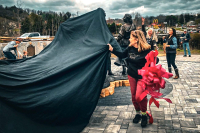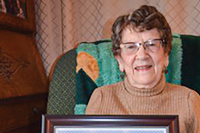Bitter cold makes routine memorable
Sunday, 6 a.m.: Get out of bed, stagger downstairs and start grinding coffee beans. What’s that white sheen through the window? Oh goodness, it must have snowed overnight! I should have moved my car. Stupid weather forecasters — they said the snow wouldn’t come through until this afternoon. So much for dinner with friends in Franklin tonight … So much, too, for getting out of here before a significant warm-up takes place. Sorry, Scott. Bet you’ll be laying out the newspaper in Waynesville on Tuesday without me.
8 a.m.: Measure snow. Three inches, and more on the way, according to the National Weather Service. Eat breakfast — French toast drizzled with tasty wildflower honey harvested last summer from the bees. Two slices of bacon. More coffee.
8:30 a.m.: Well fortified, it’s time to head down the mountain … on foot. Put on long johns, jeans, long-john top, T-shirt, sweatshirt, coat, knit cap, gloves, thick wool socks and lined rubber boots. Stop at the shed for a bale of hay, put it on a sled, continue down the mountain. I know there is a crowd of hungry goats, sheep, chickens, two guard dogs and one orange barn cat named Jack at the barn down at the mountain’s base.
8:40 a.m. I’m absolutely burning up. I’m partway down the mountain. It is in the mid 30s, and I could comfortably exist in the arctic with the amount of clothing I’ve put on … what was I thinking? Take off the coat, the knit cap and the sweatshirt. Continue to the barn.
8:45 a.m.: Finally at the barn. Coax the seven goats into their respective stalls for feeding. The billy, Boo, and the wether, Brownie, are in one stall together. Peggy Sue and Delilah in another. Sochan and Chrysanthemum in a third. Thelma — the queen goat — still eats on the milking stand where she was milked until being dried off in November. Feed them.
9 a.m.: Carry water from the spring to the animals. The small pond where I’m dipping the water is gorgeous, unbelievabley clear and ringed about with snow. The water tank was drained last week because it needed cleaning, and there hasn’t been rainfall since. I’ll be carrying hot water down the mountain tomorrow with the freezing temperatures that are expected. Scatter cracked corn to the 30 or so chickens, all absolutely miserable in this snow — they don’t like getting their feet wet. Chickens aren’t that bright, and it doesn’t dawn on them to stay in the barn. Instead, they are standing forlornly in the yard. Feed the dogs, who unlike the chickens, think the snow is terrific. Feed the cat. Feed the sheep. Look at Sophie’s udder. We think she is pregnant, but her udder isn’t showing signs of filling out, which the veterinarian said to watch for. Maybe the ewe is simply really, really fat?
9:30 a.m.: Give each of the goats a penicillin shot. This must be done twice each day for five days. A virulent cold is running through the herd. Runny noses and coughs abound. The does are pregnant, and with the added stress of severe cold, it seemed wisest to start them on antibiotics. I worked as a vet tech during college, so I’ve given shots before, but goats are proving a lot more difficult than I anticipated. It’s really hard to find enough skin to pull out for the shot — maybe I can get a veterinarian to demonstrate if I ever get off the mountain again. The goats hate the shots. I don’t blame them. I feel bad for causing them pain.
10 a.m.: Carry four bales of straw from an unused shelter to the barn, and one farther down to the sheep shelter. Break them open and scatter them about. Fall once, landing on my back, while moving the straw bales. Wonder what would happen if I broke a bone or something. The cell phone is in the house, back on top of the mountain. If I slip in the snow and no one is around to hear me scream, do I really make a sound?
11 a.m.: Dust myself off, nothing broken. Start back up the mountain, hauling the sled behind. No reason to worry about not making it to the gym today — this is enough of a workout.
11:30 a.m. Cup of hot chocolate in front of a fire. Self-congratulations for splitting and stacking wood yesterday.
Noon on: Watch birds feeding. Chickadees, finches, pine siskins, titmice, male and female cardinals in the feeders. Towhees, winter wren and juncos on the ground — all happy until a large hawk perches in a tree nearby, triggering a mass exodus. Eat salad for lunch, made with the last head of Chinese cabbage from the garden. There are still plenty of other greens, though, all tucked away for now under double and triple layers of row cover.
2 p.m. Start on this column. All in all, not a bad day, though it will be time to head back down the mountain at 4 p.m. to feed, give medicine, and tuck the animals away for the night. I like winter, even the brutal days when the simplest tasks become difficult. It makes me feel very alive.
(Quintin Ellison can be reached at This email address is being protected from spambots. You need JavaScript enabled to view it..)
New regulations are a compromise
Editor’s note: This letter was written by Waynesville’s planning director in response to Mary Lamb’s letter above.
Dear Ms. Lamb
Thank you for copying me on your message to Mayor Gavin Brown. I can’t speak for the mayor, but I was frustrated that most of your questions seemed to be aimed at attacking our process rather than genuine questions to gather information about the draft ordinance. Many people have worked very hard to produce the product that you have attacked even before understanding what it contains. My concern at both community meetings was that your insistent, repetitive and argumentative statements were dominating the meeting to the exclusion of comments from other citizens that pertained to the actual content of the ordinance.
Our steering committee was never intended to be demographically balanced. The criteria for selection was experience with the Town’s development regulations. All were appointed directly or indirectly by your elected representatives. All meetings of this committee were open and members of the media did occasionally attend.
As you have the opportunity to review the draft ordinance, I am hopeful that you will appreciate some of the changes even if you don’t agree with others. Please let us know what you don’t agree with, and how in your opinion it can be improved. That is the type of feedback that will be effective in making the ordinance better.
I’m sure you realize that all development ordinances represent compromise, so it’s unlikely that everyone will be completely pleased with the result of the revision. However, the objective of this process as I see it is to produce a set of development regulations that are more user-friendly and more importantly will make Waynesville a better place.
Paul Benson
Waynesville Planning Director
Residents need time to review zoning changes
To the Editor:
Like so many other young couples, my husband and I felt so blessed when he landed a job in this area five years ago and we were able to move and start a family in Waynesville. We had looked at living in Sylva, but immediately were attracted to the historic character and charm of this dear town and seriously impressed with the well-thought out planning of the downtown, where we currently live.
This interest in being a part of a vibrant, beautiful community led me to attend a meeting hosted by Paul Benson, planner for the town of Waynesville, on Tuesday in which the town’s newly drafted land development standards were presented to the public. Benson explained that over a more than two-year period, a committee appointed by our respected town board reviewed the old land development standards, coming up with a completely new document to be enacted into law — a document that would entirely replace our current standards.
Mr. Benson said that only 10 percent of the current law would effectively be changed; however, the changes he discussed I found to be on very critical issues (parking, setbacks, landscaping, to name just a few). Many of these changes could alter the originally planned landscape, making it appear more and more like suburban strip malls and big box centers of larger cities, not the quaint mountain town we love and that tourists love to visit.
Residents wishing to make changes to improve and protect the character of their neighborhoods have been told that this review process would be their opportunity to organize and make changes. But even after news outlets have advertised the public meeting times, the public still needs ample time to review, digest and discuss the more than 300-page document that is currently the law, along with the new 200-plus page document being proposed to supersede it. These documents are written in entirely different forms, making it very time-consuming to compare and contrast them.
Currently, neither Mr. Benson nor his committee have offered the public an easy to read list of all changes from the old law to the new—only summaries they wish to highlight and that are admittedly incomplete. They are putting the burden of review on the public, a process that again is complicated and lengthy.
Currently, the town planning board is set to begin discussion and possibly even vote on the new standards Monday, Dec. 20. This would only allow concerned citizens two and a half weeks (during the Christmas season) to review it. I would urge interested citizens to contact the Town Board and urge them to delay all voting on this plan until at least March to allow interested citizens time to read, meet and develop their own concerns for consideration.
What is the vision of Waynesville’s residents for their future? A handful of men only have spent two years revising the original standards which were developed and adopted (in 2003) with both men and women actively involved. Allowing folks a couple of months to give feedback is not too much to ask. The standards adopted by the town greatly affect the beauty, character, economic development and general sustainability of our community.
What you can do to help:
1. Email or call the Waynesville Aldermen, the chair of the Planning Board and the Town Planner and ask them in your own words to postpone any vote on adopting the Land Development Standards until at least March.
Mayor Gavin Brown, This email address is being protected from spambots. You need JavaScript enabled to view it., 828.452.2491
Alderman Gary Caldwell, 828.456.3138
Alderman Elizabeth Feichter, This email address is being protected from spambots. You need JavaScript enabled to view it., 828.456-6918
Alderman J. Wells Greeley, This email address is being protected from spambots. You need JavaScript enabled to view it., 828.456.7288
Alderman LeRoy Roberson, This email address is being protected from spambots. You need JavaScript enabled to view it., 828.456.7142
Town Planner Paul Benson, This email address is being protected from spambots. You need JavaScript enabled to view it., 828.456.2004
Planning Board Chair Patrick McDowell, 828.508.4932
2. Attend the Waynesville Planning Board meeting at 5:30 p.m. on Monday, Dec. 20, in the upstairs room of the new downtown police station to ask the entire planning board to postpone their critical vote on this issue until at least March.
3. Forward this letter and info to anyone Waynesville residents you know who are concerned with Smart Growth, historic preservation and maintaining the character and charm of our community. Post information on any Facebook or other social networking site you regularly use to contact your Waynesville friends, family, co-workers and neighbors.
4. Contact me with your other ideas on how we can work fast to take advantage of this window of opportunity for making positive change in our community. A small group of concerned citizens is currently forming to carefully review the new plan and we would love your help.
Mary Alice Lamb
Waynesville
Jackson’s new leaders have room for improvement
A bit of a stumble out of the gate can be forgiven among newcomers in any endeavor, but that stumble also means more intense scrutiny is likely to follow.
That’s exactly what happened with the new Jackson County commissioners, and voters are surely hoping there are better times to come.
A perfect storm of factors — bad economy, controversial county manager, and the pre-election Tea Party surge, among them — led voters to sweep every incumbent up for election out the door in the Jackson County commissioners race.
Citing those factors and others as a reason for the victory is not meant as a criticism of the new commissioners. The three — Jack Debnam, Charles Elders and Doug Cody — obviously impressed a lot of voters they came into contact with. Americans have a near religious fervor regarding the will of the people, and that will expresses itself every time we hold an election. It’s winners take all, and that’s just the way it is.
No, critics of any newly elected leaders would be advised to wait until those leaders take office — or at least begin making decisions — to start finding fault. In Jackson County, that didn’t take very long.
First was the way the retirement of Ken Westmoreland was handled. There was little doubt Westmoreland and the new board would not see eye to eye, and that his tenure as county manager was, for all intents and purposes, over. And as Westmoreland himself told this newspaper, a new board “has every right, prerogative and the authority to put in their own management team …. I don’t understand why (Jack Debnam) felt the need to deny it, but it just didn’t come out that way, I guess.”
Westmoreland is referring to Debnam’s leak to the local media that Westmoreland had decided to retire, and Debnam saying the county manager had done so of his own volition. Westmoreland denies that it was his decision. He said Debnam put it to him like this: “He said, ‘the three of us have talked it over and we would like a change.’”
So one of the two men is dead wrong, which means someone is lying. Let’s just repeat the earlier assertion, that this wasn’t handled very cleanly.
There are also a couple of other issues with the early work of the new board. It changed the starting time of one of its monthly meetings to 2 p.m. That means any working folks are excluded. That doesn’t send a very good message.
The board also moved the public comment session of its meeting to the very end of the agenda. I’ve been fortunate enough to have attended hundreds of public meetings over the years, and they are, well, somewhat less than riveting. To make citizens who want to talk hang around until commissioners have finished their business is, well, a bit rude. Let the public have their say and then leave. They aren’t paid to be there, but commissioners are.
As I said early on, even elected officials deserve a bit of a pass on early mistakes. What citizens want is sound, thoughtful leadership. Only time will tell if this is what they got.
(Scott McLeod can be reached at This email address is being protected from spambots. You need JavaScript enabled to view it..)
Guilty as charged, and free at last
I have a confession to make. Underneath my tough, no-nonsense newspaperwoman exterior, I’m an individual who is ridden with guilt.
I can go inside myself at any given moment and touch on a multitude of reasons to justify feeling guilty. Having spoken rudely to someone, not believing I’ve put enough effort into a news article, terminal procrastination, not spending adequate time with my cats — anything and everything will do.
This, for me, is normal. And because I’m accustomed to me, life is familiar if not always comfortable. That’s not to say I don’t welcome lightening the load. So I’m happy to note one longstanding issue, where my crime was real and my guilt justified, has been resolved.
I no longer reside in the bad-girl files of the Fontana Regional Library System. I wrote a check to the Jackson County Public Library for $178.65. It didn’t just make me feel better — head librarian Dottie Brunette was delighted. Even the other library employees seemed to enjoy the event, a celebratory moment in an otherwise dull day, I guess.
At a recent dinner party, Dottie had flatly refused a request to expunge my record. I wanted my own library card after relying on borrowed ones for 15 years. Jackson County is building a beautiful new library. When it opens, I want to march in and check out books using my real name.
That’s what friends are for, I reasoned before asking Dottie. To undertake small personal favors for each other and, in this manner, make the difficult journey through life a bit gentler and easier. Kind of like the Freemasons or something, I thought. Except, of course, we don’t have secret decoder rings or handshakes or temples in which to gather.
Ha. I should have known better. Instead, Dottie delivered a l..o..n..g lecture on the library’s needs, its limited budget, the value of books in general, the noble role librarians play in the world, and so on. She capped it off with how she, Dottie, always pays her library fines and dammit, she’s the head librarian isn’t she? So the least I could do is pay my fines, too.
What I wanted to do by that point was have a big glass of wine or two, but because I’ve sworn off drinking for now I couldn’t do that. So I glared at Dottie instead. Then I realized she was (dammit) right. I needed to pay the fine.
Here is where I start looking good.
When I went to the library and asked Dottie exactly how much was owed, she informed me there were choices. In a pained voice, she admitted in a matter of months, because of the sheer length of time that had passed, my fines would erase automatically. Then I could get a library card — for free.
I hesitated. I thought long and hard about the uphill battle for funding the library system is facing during these tough economic times. And of the almost indescribably important part libraries have played in my life and heart.
My father drove the bookmobile at one time for Fontana Regional Library System, so I spent many days after school and during the summer at Marianna Black Library in Bryson City. When my mother worked in Sylva, my afternoons were occupied with reading books and magazines at the Jackson County Public Library. One of Dottie’s predecessors, Jeanette Newsome, and other women who worked there kept a close eye on me. I love them for that to this day.
When I lived in Cashiers and was dreaming of farming instead of writing, I found books at the library to sustain and inform me. Working at The Franklin Press and for the first time truly living on my own, I relied on the Macon County Public Library as a free source of reading material and entertainment.
Which is where I got into trouble — during a move in Franklin from one house to another, a box of library books and records disappeared. I have no idea what happened to them. At that time I was too poor to pay the fine. Later I just used the borrowed library cards and tried not to feel guilty.
Jackson County Library’s workers gave me a list of what exactly I was paying for: 11 books and a double-record album — opera arias, no less. In October 1995, I was reading Jim Chee mysteries, books on feature writing and photography, Spoon River anthology, and more.
I still enjoy Jim Chee mysteries and opera arias. Maybe now the library system can afford to replace the books and buy some CDs. And I can check them out. Using my very own — and very expensive — library card, thank you very much.
(Quintin Ellison can be reached at This email address is being protected from spambots. You need JavaScript enabled to view it..)
Remembering Terry … and not too fondly
When I was in the fourth grade, some dirtbag stole my hat. But it wasn’t any old dirtbag, and it wasn’t any old hat. The dirtbag was a kid named Terry, a garden variety bully with no manners, questionable hygiene, and no regard for people’s personal property. In other words, he was the kind of dirtbag who would steal another guy’s hat, and then wear it proudly the next day, as if it were a trophy, as if he were daring the victim to do something about it.
Under normal circumstances, I would have probably just let it go. A hat is a hat, not worth fighting over, and a dirtbag is just a dirtbag, no shortage of those in the halls and on the playground. However, this was not just any hat. It was a brand new Los Angeles Dodgers baseball cap that I had just got as a birthday present from K&E Sporting Goods. I still remember the day I picked it out, tried it on, felt the stiffness of the bill as I began shaping it into a curve. I was a big Dodger fan, as was my dad. I thought that there was no blue like the blue in brand new Dodgers baseball cap, not even the sky.
I wore it all the time, to church, to school, even to supper, where my mother patiently let me eat my fried perch and mashed potatoes without making me take it off. Unfortunately, my fourth grade teacher would not allow me to wear my hat in class, so I had to put it in my locker, which was not really a locker but a little wooden cube barely big enough to stuff a windbreaker into, a cinch for even the most dull-witted thief, and Terry certainly was that.
When I discovered my Dodgers cap had been stolen, I had a feeling that I am not quite sure I can adequately describe. I felt angry, yes, but more than that, I felt confused and violated, as if the natural order of things had suddenly come undone and I had not been alerted to the new way of things. What if Monday suddenly followed Friday and someone had taken the weekends? What if someone had removed all the tater tots in the entire world? What if someone took all but three days of summer vacation?
Something important had been taken from me, by someone who had no business or right to take it. It was mine and now it was gone. I remember looking at the empty “locker” for a long time, as if looking hard enough might somehow force the hat to materialize right before my eyes. To be honest, I felt more sick than angry.
That was a long time ago, but I still remember the feeling vividly. A couple of weeks ago — on Black Friday — my wife was shopping at Belks when someone stole her pocketbook. She was looking at shoes, and had maneuvered her cart between two nearby rows of clothes so that it would not further clutter up the area. She had turned her back for just a few minutes, only to find when she turned back for the cart that it was gone … along with her pocketbook and everything in it, including her wallet, credit cards, license, photographs, whatever money she had, her keys, cell phone, and assorted other, more easily replaceable, items. When she looked at that space where her cart had been, I imagine she felt very close to how I felt when I looked at my empty locker all those years ago. I know she did, because I could hear it in her voice when she called me at about 5 a.m. on Friday morning, her voice trembling and frail.
It wasn’t just that her pocketbook had been stolen. We were able to cancel the credit cards, contact the bank, replace the cell phone and keys, and change the locks on the house easily enough. Luckily, she hadn’t been carrying much cash, so it turned out that the monetary loss was fairly minimal. The bigger injury by far was that feeling of violation, that the natural order of things was out of whack, that at any minute for no apparent reason someone will take what’s yours when your back is turned. She’ll get over this, of course, but it will take her longer to get over the sense of violation than it will to get over what she lost.
I ended up getting my hat back, by the way. And, years later, Terry ended up dropping out of school and going to jail. The moral? Sometimes, the natural order of things may be temporarily upset, but in the end, it’ll kick your ass. I think Aristotle said that, probably after some young Athenian stole his sandals.
(Chris Cox is a writer and teacher who lives in Haywood County. He can be reached at This email address is being protected from spambots. You need JavaScript enabled to view it..)
More effort need to combat underage drinking
By Patti Tiberi • Guest Columnist
“Alcohol is the most widely used substance of abuse among America’s youth. A higher percentage of young people between the ages of 12 and 20 use alcohol than use tobacco or illicit drugs. The physical consequences of underage alcohol use range from medical problems to death by alcohol poisoning, and alcohol plays a significant role in risky sexual behavior, physical and sexual assaults, various types of injuries, and suicide. Underage drinking also creates secondhand effects for others, drinkers and nondrinkers alike, including car crashes from drunk driving, that put every child at risk. Underage alcohol consumption is a major societal problem with enormous health and safety consequences and will demand the nation’s attention and committed efforts to solve.”
This is a direct quote from former Acting Surgeon General Rear Admiral Kenneth Moritsugu, from his “Call To Action” in 2007. But one may wonder why there is all this fuss about underage drinking. Isn’t it just something that is “a rite of passage?” Don’t all kids do it?
Well, the answer is no. Many of us like to look back and say, “We survived it, they will too!” Truth be told, there are many that did not survive it and they are not here to tell their side of the story. Many of us ended up going through many years of grief as we struggled to manage our disease of alcoholism. Few people in recovery speak out in public about their struggles to manage their disease. There is still a very strong stigma attached to having alcoholism.
But the reality is that more young people in the U.S. drink alcohol every month than smoke cigarettes or use any illegal drug. Additionally, alcohol kills more young people per year than all illegal drugs combined!
Many studies show that media advertising of alcohol products is a major factor in decisions made by 12- to 20-year olds to start drinking or drink more heavily if they are already drinkers. In a recently released report, the Center for Alcohol Marketing and Youth (CAMY) noted that, since 2000, many alcohol companies have voluntarily reduced their advertising in markets with greater than 30 percent underage audiences.
However, the report stated that alcohol advertising in markets with more than a 15 percent youth population still results in overexposure. While the industry has made progress, more needs to be done to limit the amount of alcohol promotion our young people see on TV, movies and in magazines.
The availability of alcoholic drinks that have a sweet taste, like lemonade, is also a concern because they seem designed to appeal to young people. Plus, alcohol products like malt liquor can often cost less than soda. Even if it can’t be purchased legally by young people, the low cost makes it easier to pay someone to purchase it for them.
Children are beginning to drink at an earlier age in a day when we know much more about the impact that alcohol use has on the changing adolescent brain. Our science now reports that youth who begin drinking before the age of 15 are four times more likely to develop alcohol dependence. But every day in our country, 7,000 youth under the age of 16 take their first drink.
While we used to find that boys drank more heavily than girls, we now see that girls have caught up and are drinking just as heavily. (Institute of Medicine, National Research Council of the National Academics)
It is important that you help. First thing, please help to reduce the availability of alcohol to youth under 21. If you have alcohol at home, keep it in a secure place and monitor it. Second, help support law enforcement in targeting the underage drinking issue. This could be something as simple as getting to know the parents of your child’s friends and agreeing with them about not serving alcohol to youth under 21. Third, get involved locally to help change your community’s norms around alcohol use. Learn more about the issue by checking out the following websites: alcoholfreechildren.org, ncpud.org, faceproject.org, and drugfree.org.
(Patti Tiberi is the Regional Prevention Coordinator at Smoky Mountain Center and the Chair of Healthy Haywood’s Substance Abuse Action Team. For more information on how to get involved with a Health Action Team, go to www.healthyhaywood.org or call 828.452.6675. Healthy Haywood is a program of the Haywood County Health Department and certified Healthy Carolinians partnership.
Kephart, transplants and the debate over legitimacy
You can be excused for perhaps having overlooked the recent fireworks, but a minor war has erupted over one of this region’s favorite sons (or, not-favorite sons).
Pick your side.
Horace Kephart, the definitive writer of Western North Carolina history who set up a home of sorts in Swain County and gave us an accurate portrait of the mountaineer as he was then.
Or, Horace Kephart, who wasn’t even from this region. Who gave us a not very accurate portrait of the mountaineer of yore, and, if that isn’t enough to make you dislike him, was a good-for-nothing drunk who suffered a mental breakdown and stranded his family to boot.
I have an unusual, albeit somewhat shallow, interest in these matters. I live in WNC today because of Kephart. My family moved to the Bryson City area in the early 1970s because my parents fell in love with the region while Dad was doing research on Kephart. My father, George Ellison, wrote the introduction to Our Southern Highlanders when the University of Tennessee Press reissued it in 1976.
Other republications of Kephart’s books, and new information about the man himself, have been taking place these past few years. This has set the stage for a bunch of arguing about Kephart’s importance, the value of his books, and so on. My Dad hasn’t been part of that, best I can tell. He just keeps working on the material. And there’s been a lot of it to plow through, because the Kephart family is providing boxes and boxes of previously unexamined documents.
Here is the central argument of Kephart’s detractors, though they aren’t necessarily as direct about it as I am in this rephrasing: Kephart wasn’t from here. Thus, he had no right to portray the mountaineer at all. Only those born and bred in these hills, with roots that go back for generations, have a right or the ability to write about the people of these mountains. Everyone else is an outsider and doesn’t “get it.”
Phooey. I’m not from here, yet I maintain I’ve got a perfect right to portray whomever I want to, whenever I want to, how I want to, in whatever form I desire. Fiction, nonfiction, newspaper or magazine articles, columns, whatever interests me in a given moment as a writer. Who is going to stop me, pray tell? And if I do write about this region, what gives someone else the special insight to say my writing lacks value simply because I’m not born and bred of the hills?
I was born in Richmond, Va. If I abided by the underpinnings of this anti-Kephart argument, I would only write about people from Richmond (of which I know nothing, since we left there when I was six months old).
The argument is specious at best, and arrogant at worst. Let’s take it one step further, and the lack of logic becomes clear: Henry James wasn’t from Europe, so he shouldn’t have included Europeans in his novels. Ridiculous.
Joseph Conrad was Polish, so he shouldn’t have mastered English and written all those masterpieces, and about British people, for goodness’ sake.
Sue Hubbell, my current favorite nonfiction writer, hails from Michigan. Shouldn’t have written all those great books about living in the Missouri Ozarks, Sue.
Here’s the other angle of this anti-Kephart fervor. Not being from here, Kephart just didn’t understand — he overemphasized the moonshining and illicit behavior, and underemphasized the refined dignities of the mountain people.
Maybe. Maybe not. That’s the neato thing about being a writer. You get to emphasize whatever interests you. And Kephart was very interested in moonshine. How it was made, and how it tasted. He spent a lot of time sampling the local offerings, and clearly became something of a connoisseur.
Additionally, if we are going to condemn every drunk who was a writer, say farewell to William Faulkner, F. Scott Fitzgerald, Tennessee Williams, Eugene O’Neill, Ernest Hemingway and plenty of others who found their muses in the dregs of wine cups and beer bottles. Kephart apparently often found his floating around near the bottom of a moonshine jar. So what does that prove about the worth of his work? Not a thing.
He was probably a lousy father and husband, but again, what in the world does that have to do with the quality of his writing, or his portrayal of Southern Appalachia? Not much.
A good place to take in the this-side and that-side of the great Kephart debate is www.tuckreader.com, a valuable recent addition to the local news scene. Check out the battle of words (both are being ever-so-courteous) taking place between Jim Casada and Gary Carden, both fine regional writers born and raised in WNC. Jim is from Bryson City, Gary from Sylva.
Better yet, read Kephart’s books and make an independent determination of your own.
(Quintin Ellison can be reached at This email address is being protected from spambots. You need JavaScript enabled to view it..)
Time to fully fund the Land and Water Conservation Fund
By Brent Martin • Guest Columnist
The craziness of this year’s mid-term elections has passed. The campaign advertisements and signs are coming down. The dust is starting to settle. But one thing should remain top of mind for those Senators returning to conclude the 111th Congress — there’s still a lot of work to be done.
Members of Congress should also take note that even in the midst of a difficult economy and political sea change there continues to be strong and bipartisan voter support for investments in land conservation and parks. On Election Day, voters approved 28 of 35 (80 percent) of state and local measures on the ballot to finance land conservation and parks, including statewide measures in Oregon, Iowa, Maine and Rhode Island. In Arizona, voters overwhelmingly rejected Prop 301 that would have raided voter-approved open space funds and put them to the general budget if approved.
With public support for conservation and recreation in mind, one issue facing senators as they return for the lame duck session on Nov. 15 is the need to finally provide consistency for a program that has done more for local communities and our country than most people realize. Signed into law in 1964, the Land and Water Conservation Fund (LWCF) was designed to dedicate a portion of revenues from offshore oil and gas development for land conservation and outdoor recreation throughout the country — a promise that has been chronically unfulfilled.
LWCF was supposed to receive $900 million per year — a drop in the bucket of offshore revenues that typically tally well over $5 billion — but has been shortchanged by Congress nearly every year, with revenues regularly being diverted to other purposes. Full funding has been appropriated only once in the LWCF’s 46-year history and recently declined to a low of $138 million in 2007. This shortfall has resulted in a huge backlog of unmet funding needs for land protection and outdoor recreation for our federal public lands, and state and local parks.
And yet in spite of rarely receiving its due, LWCF has been instrumental in many of the places that are most dear to us as a nation. From local parks and playgrounds, where kids can get outside to play, to greenbelts and recreational trails that connect and enhance local communities, to state parks that provide hiking, biking, and camping and help to sustain wildlife, to federal public lands used for hunting, fishing, paddling, and our most pristine national parks, wildlife refuges, and wilderness areas — LWCF has provided a continuum of conservation that has touched us all. Close to home, LWCF has provided over $60 million and protected almost 40,000 acres in North Carolina since its inception in 1964, protecting places like Catawba Falls, the Appalachian Trail, and Lake James.
Given the tragic oil spill in the Gulf this summer, the vision behind the Land and Water Conservation Fund is even more relevant than ever and now is the time for action. In a national bipartisan poll conducted by Public Opinion Strategies and FM3 in May, 85 percent of respondents view the LWCF as more important today in light of the oil spill. And now, with the offshore moratorium having been lifted once again and the oil spill still fresh in our minds, it is only right to ensure that some of the revenues from the use of this resource are used to protect our precious land resources.
On July 30, the U.S. House of Representatives took on this challenge by passing the Consolidated Land, Energy and Aquatic Resources (CLEAR) Act of 2010, H.R. 3534, including full, dedicated funding for LWCF with the support of Congressman Heath Shuler (D-NC). In addition, LWCF was a centerpiece of the Administration’s “America’s Great Outdoors” listening sessions throughout the country this summer and is expected to be a priority as that initiative continues to take shape.
But the Senate needs to act in order to capture this opportunity and momentum to finally ensure LWCF receives its due. Please write Senators Burr and Hagan and encourage them to work with Senate leadership to ensure that full and dedicated LWCF funding is included in energy or other relevant legislation and enacted before the end of this Congress.
(Brent Martin lives in Macon County and works for the Wilderness Society. He can be reached at This email address is being protected from spambots. You need JavaScript enabled to view it..)
Striking a balance between objectivity and truth
There is an interesting disconnect in how some people perceive my job and how I perceive my job. This was brought home to me recently while working on articles about efforts to revive Cullowhee.
Additionally, working on this week’s cover story about community journalism got me all fired up and excited. I remembered how much fun it was to work in Macon County as a cub reporter. Working on the cover story gave me real hope for the future of newspapers. Paper, computer screens, who cares how newspapers are published as long as we get to cover local events.
I do believe people who work for newspapers need to do a better job of (ahem) communicating. For professionally trained communicators, as a group we are simply terrible at telling our own story. We are equally bad at explaining why we do what we do and about how we put articles together. No wonder people believe there is a vast media conspiracy. In our reluctance or inability to communicate, we’ve allowed others to speak for us. And they’ve not been kind.
Here’s my attempt to take my own advice: I used the word “watchdog” in an article to describe a new group that, in my mind, is promising to do just that with Western Carolina University.
Robin Lang, the spokeswoman for the new group, said she was aware some people had reacted negatively to the word. But she did not react that way herself in conversations with me. Robin isn’t one to back down when she believes in something, and this is something she clearly feels strongly about.
As I mused on the discussions I was having with other folks, however, the answer to what was happening dawned on me. People in Cullowhee and Forest Hills are working hard to do something positive for their community. They don’t want some vagabond reporter to derail those efforts by upsetting the powers that be.
I don’t believe this is from a desire to oppress the press, but because they don’t want to alienate anybody. Particularly WCU. Though I’m not clear whom exactly they mean by that, or what they think will happen if someone there does get pissed off. It’s not like WCU can pack its bags and go setup shop someplace else. If they are worried about Chancellor John Bardo getting mad, so what if he does? He’s planning to retire next summer, anyway.
This led me to mull over how I approach newsgathering and writing. It doesn’t always match exactly with policies at the places I’ve worked, but I do try to work places that are, in the main, congenial to my viewpoint.
• I’m not covering events in an effort to influence them. I’m not devoid of opinion — journalists who say they don’t have opinions on issues are lying, to themselves and to you. Ask me what I think and I’ll probably tell you. Like a good jury, however, my inner judge demands I set my opinions aside and listen and report.
Let’s keep picking on Cullowhee revitalization for a moment. I sincerely hope efforts there work. In fact, I might even help plant flowers or something. But it’s not my job to make things work — or to dally with coverage so that it’s palatable to those in authority. If someone designated a group’s spokesperson speaks, acts and behaves like a watchdog, and I use the word watchdog in a follow-up article, well that’s how the cookie crumbles and I make no apologies. Pick a less forthright spokesperson next time if my accurate rendering is bothersome.
• I don’t use anonymous sources unless someone is in actual physical danger. The last time I relied on an anonymous source was about six years ago. I was reporting on sexual abuse in the state’s juvenile prison in Swannanoa. The boy I interviewed had been molested. He was in true physical danger if identified. Using anonymous sources in lesser cases, in my book at least, is lazy reporting. It might take longer and involve more effort, but you can generally get any story into print with identified sources. If you can’t get it on the record, that’s an indication the newspaper needs to review whether the story should be printed in the first place.
• I believe, with all my heart, in the fundamental importance of journalism. Journalists have a unique and vital role to play, particularly at the smallest newspapers. There is a tradeoff: at a mid-sized to large daily you are somewhat insulated from readers’ and newsmakers’ opinions regarding your work. The quick turnover of news — a daily newspaper simply doesn’t stay on a restaurant table for a week getting repeatedly read and scrutinized — and the very largeness of a daily newspaper’s organization makes it difficult for readers to recognize individual journalists.
That’s not the case here, or at The Franklin Press, The Sylva Herald, The Macon County News, the Crossroads Chronicle, or at any other community newspaper in the region. I can’t even slip into a grocery store in Sylva to buy bread without hearing someone’s take on that week’s edition of The Smoky Mountain News.
I won’t lie. Sometimes this gets old, particularly when I’ve had a long day dealing with uncooperative sources, or when the words won’t come no matter how hard I glare at the computer screen. Or if I’ve made a particular egregious booboo, or if I’ve been trying to get to the gym all day to work out, and I just stopped for a minute at the grocery store and now I’m cornered with my back to Annie’s Bread display hearing about it, whatever it might be, and I’m watching the time tick away knowing I’m not going to get to work out because I’ve got to get home by a certain hour.
But, and this is the truth, I am also extraordinarily glad people feel free to speak their minds or email me about coverage, and I hope this column doesn’t give the opposite impression. The comments force me to assess what I’m doing, how I’m doing it and whom I am doing it to. This might not always be comfortable, because, bottom line, sometimes I’m wrong or misguided or I’ve screwed things up, but overall it is a fine thing.
We (listen up, my newspaper friends) need in turn to pay readers the respect of being equally engaged. And to understand that being objective and uninvolved doesn’t mean standing passively by and not telling our stories in turn. If we don’t speak, others will speak for us. Chances are, we aren’t going to like what they say.
(Quintin Ellison can be reached at This email address is being protected from spambots. You need JavaScript enabled to view it..)









